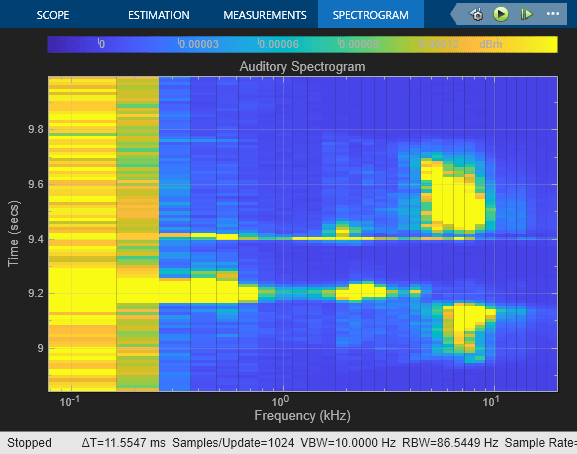Design Auditory Filter Bank
Libraries:
Audio Toolbox /
Features
Description
The Design Auditory Filter Bank block outputs a frequency-domain auditory filter bank. You can use an auditory filter bank to decompose an audio signal into separate frequency bands for feature extraction.
Examples
Ports
Output
Auditory filter bank, returned as an M-by-N matrix, where:
M is the number of bands, which is determined by the Auto-determine number of bands and Number of bands parameters.
N is the number of points in the spectrum. If you select Design one-sided filter bank, then N is equal to
ceil(NFFT/2)NFFTis the FFT length. If you do not select Design one-sided filter bank, then N is equal to the FFT length.
This port is unnamed until you select the Output center frequencies parameter.
Data Types: single | double
Center frequencies of the bandpass filters in Hz, returned as a row vector with number of elements equal to the number of bands.
Dependencies
To enable this port, select the Output center frequencies parameter.
Data Types: single | double
Parameters
Frequency scale used to design the auditory filter bank, specified as
mel, bark, or
erb.
mel–– Design the filter bank as half-overlapped triangles equally spaced on the mel scale.bark–– Design the filter bank as half-overlapped triangles equally spaced on the Bark scale.erb–– Design the filter bank as gammatone filters whose center frequencies are equally spaced on the ERB scale.
Style of the mel scale, specified as oshaughnessy or
slaney.
Dependencies
To enable this parameter, set the Frequency scale
parameter to mel.
Number of points used to calculate the DFT, specified as a positive integer.
When you select this parameter, the block designs a one-sided filter bank. Otherwise, the filter bank is two sided.
When you select this parameter, the block automatically determines the number of bandpass filters based on the Frequency scale parameter.
Number of bandpass filters, specified as a positive integer.
Dependencies
To enable this parameter, clear the Auto-determine number of bands parameter.
When you select this parameter, the block sets the Frequency range
to [0,fs/2], where fs is specified
using Sample rate (Hz).
Frequency range in Hz over which to design the auditory filter bank, specified as a two-element row vector.
Dependencies
To enable this parameter, clear the Auto-determine frequency range parameter.
Domain in which the block designs the filter bank, specified as
linear or warped.
Set the filter bank design domain to linear to
design the bandpass filters in the linear (Hz) domain. Set the filter bank
design domain to warped to design the bandpass
filters in the warped (mel or Bark) domain.
Dependencies
To enable this parameter, set Frequency scale to
mel or
bark.
Normalization technique used for the filter bank weights, specified as
bandwidth, area,
or none.
bandwidth–– Normalize the weights of each bandpass filter by the corresponding bandwidth of the filter.area–– Normalize the weights of each bandpass filter by the corresponding area of the bandpass filter.none–– The block does not normalize the weights of the filters.
Data type of output, specified as double or
single.
Sample rate in Hz of the filter design, specified as a positive scalar.
Open plot to visualize the filters in the frequency domain.
When you select this parameter, the block displays an additional output port, fvec. This port outputs the center frequencies of the bandpass filters.
Block Characteristics
Data Types |
|
Direct Feedthrough |
|
Multidimensional Signals |
|
Variable-Size Signals |
|
Zero-Crossing Detection |
|
Extended Capabilities
C/C++ Code Generation
Generate C and C++ code using Simulink® Coder™.
Version History
Introduced in R2022aSet the Mel style parameter to
slaney to use the Slaney-style mel scale.
See Also
Blocks
Functions
Objects
MATLAB Command
You clicked a link that corresponds to this MATLAB command:
Run the command by entering it in the MATLAB Command Window. Web browsers do not support MATLAB commands.
Seleziona un sito web
Seleziona un sito web per visualizzare contenuto tradotto dove disponibile e vedere eventi e offerte locali. In base alla tua area geografica, ti consigliamo di selezionare: .
Puoi anche selezionare un sito web dal seguente elenco:
Come ottenere le migliori prestazioni del sito
Per ottenere le migliori prestazioni del sito, seleziona il sito cinese (in cinese o in inglese). I siti MathWorks per gli altri paesi non sono ottimizzati per essere visitati dalla tua area geografica.
Americhe
- América Latina (Español)
- Canada (English)
- United States (English)
Europa
- Belgium (English)
- Denmark (English)
- Deutschland (Deutsch)
- España (Español)
- Finland (English)
- France (Français)
- Ireland (English)
- Italia (Italiano)
- Luxembourg (English)
- Netherlands (English)
- Norway (English)
- Österreich (Deutsch)
- Portugal (English)
- Sweden (English)
- Switzerland
- United Kingdom (English)

